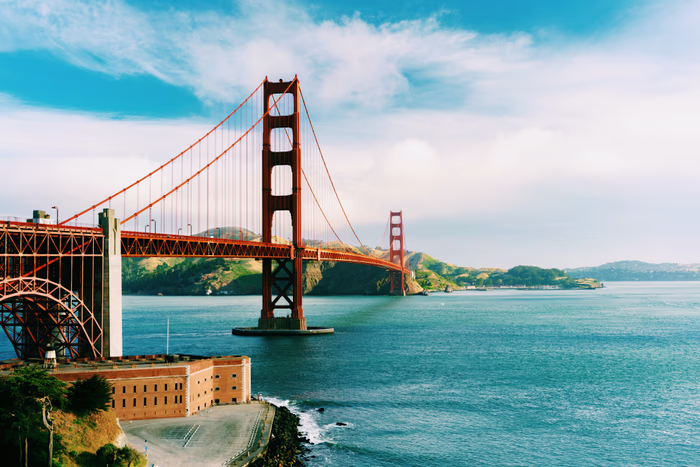In previous posts of the Personal Finance Basics series we covered:
- How the stock market works
- What the S&P 500 and the Dow are
- The pitfalls of investing in the stock market
As a summary, we learned that:
- The stock market is a crowd of people buying and selling shares of companies in an attempt to make money.
- Investors buy shares if they believe the company is undervalued and will grow in the future.
- They sell shares when they believe the company is overvalued or will not grow as fast as it has in the past. Or, as often happens in the case of inexperienced investors, because they need the money or are panicking about a price drop.
- The S&P 500 and the Dow are two popular indices used to track the performance of the stock market.
- An increase in the S&P 500 or the Dow means that the stock prices for the companies they track—as a whole—went up.
- The stock market can be a dangerous place.
- It’s easy for stock trading to become gambling. The combination of money and primal human emotions is a dangerous cocktail.
- Modern stock trading apps like Robinhood use the social media app playbook to capitalize on FOMO and turn young people into gamblers rather than investors.
- Picking the right companies to invest in is difficult because new technology, relentless competition, and poor decisions can sink even the mightiest Goliath.
- And picking the right companies isn’t enough. We also have to get the timing right—buying or selling at the wrong time can lead to heavy losses.
In this post we’ll go a bit deeper into the dangers of the stock market and then discuss why investing, despite its inherent dangers, can still be a winning proposition.
The stock market goes up over time
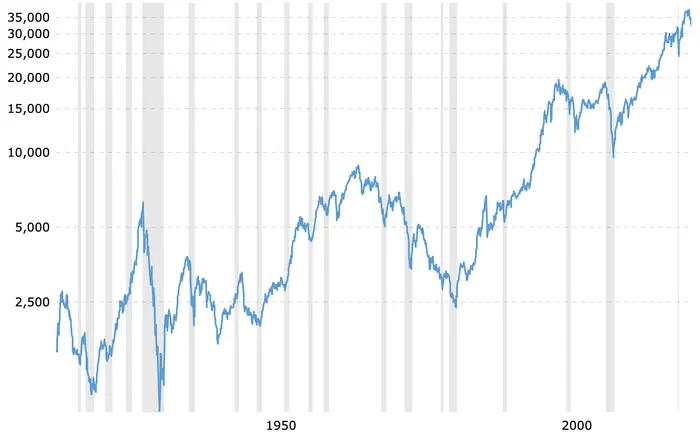
Chart courtesy of Macrotrends.
The chart above shows the trajectory of the Dow Jones Industrial Average (DJIA, aka the Dow) from 1915 to 2022.
There are three things that stick out to me when looking at this graph:
- The gray bars
- These bars indicate recessions. The thick gray bar from 1929 to 1933 is the Great Depression and the one from 2007 to 2009 is the Great Recession.
- We’re all scared of recessions (i.e., losing our jobs, not being able to make ends meet, shortages), but these occur about once every decade—almost like clockwork. Recessions will happen so we need to be prepared.
- The index goes up over time
- It’s gone from around 1,5001 in 1915 to 33,000 in 2022. That’s an increase by a factor of 22.
- The rollercoaster-like volatility
- While the general trend is up and to the right, there are plenty of bumps along the way. See 1929 (Great Depression), 1980 (Reagan recession), 2007 (Great Recession), and 2020 (COVID).
- Precipitous stock market drops are as inevitable as recessions. They will happen so we should be prepared.
Points number one and three (recessions and volatility) are warnings—we need to be ready for the worst.
Point number two is the silver lining.
The up-and-to-the-right trajectory of the DJIA explains what people mean when they say that “the stock market goes up over the long term.”
It explains how a dollar invested in 1915 turned into $1,225 by 2022.2
If we’re in it for the long run and have the stomach to sit tight through the cliff drops, the stock market will reward us for our time and patience.
The stock market is a device for transferring money from the impatient to the patient.
Companies go bankrupt
We have to be careful, however, about extrapolating the behavior of the stock market as a whole to the behavior of each company in the stock market.
The fact that the stock market as a whole goes up over time does not mean that every company in the stock market goes up over time.
This is an important point that’s worth emphasizing:
The long-term behavior of the whole is not the same as that of the individual.
As an example, the crime rate in the U.S. has greatly decreased over the past thirty years.
This does not mean, however, that the crime rate has decreased in every city! Several cities, in fact, have seen their crime rate increase.
But when the country is taken as a whole, the crime rate is down considerably.
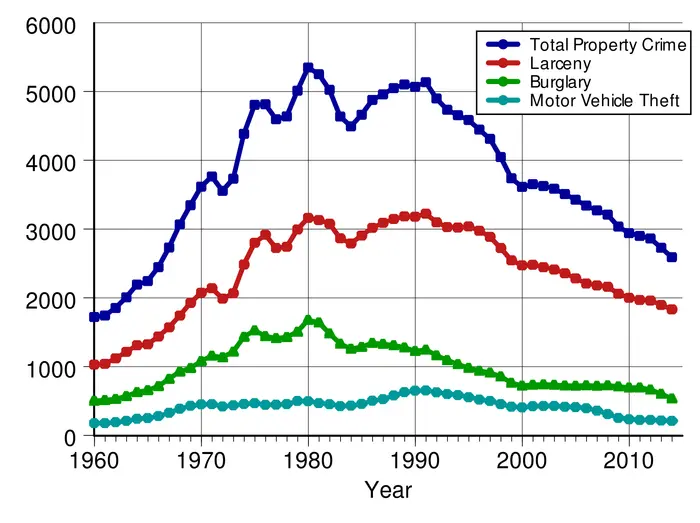
Chart courtesy of Wikipedia.
The two conclusions we need to draw from this fact are that:
- You can expect that the stock market as a whole will grow over time.
- You CANNOT expect this from any one particular company.
Every day, new companies are being founded. And every day, existing companies are going out of business.
Relentless competition, the creation of new technology, and poor leadership are all factors in this natural cycle.
Blockbuster had over 9,000 stores in 2004.
Yet by 2010, Blockbuster was $900 million in debt and down to 3,000 stores due to the rise of video streaming services like Netflix and Hulu (new technology + competition).
Ironically enough, Blockbuster could have bought Netflix in 2000 but declined (poor leadership).

A chart of the stock price of Sears from 2003 to 2022
Sears is another example.
Sears was once a titan—perhaps best embodied by the fact that Sears Tower in Chicago was the world’s tallest building from when it was built in 1973 until 1998 when Petronas Towers in Malaysia took the crown.
Given its current decline, it’s almost impossible to understand how deeply woven into the fabric of America Sears was. Walmart, Amazon, and Costco all borrowed heavily from the Sears playbook.
A long series of mistakes and an inability to adjust to the competition, however, sank the company and Sears today is a worthless shell, counting down the minutes until it’s finally dead.
Netflix’s decline
But Blockbuster and Sears are old farts, you might protest. I would’ve never bought shares in such smelly, old-time companies.
How about Netflix then? Is Netflix cool enough to invest in?3
Netflix is ubiquitous—it’s used so much that it accounts for 12% of Internet traffic.
Nearly every household in the U.S. has access to an account. Heck, not only in the U.S. but the world—go to any major city and you’ll find giant billboards promoting the latest Netflix offering.
They’ve produced hit after hit after hit (Stranger Things, Tiger King, Money Heist, Bridgerton, and Squid Games, among others).
New season drops dominate conversations around the dinner table and the water cooler (or Slack chat rooms) for weeks.
Netflix’s growth and cultural impact has been insane and investing in Netflix has been highly lucrative—a dollar invested in Netflix in 2010 grew to $55 by 2020.

A chart of the stock price of Netflix from 2002 to 2022
But the magic is gone—just look at the cliff drop that started at the end of 2021.
The golden child has been kicked out of the house. People are ticked off about the price increases and are flocking to Disney+ and HBO Max.
In April 2022, Netflix announced that they had lost 200,000 subscribers. Almost overnight, Netflix’s beautiful carriage turned into a pumpkin and people lined up to take a crap on their doorstep.
The once-undisputed king is now on the back foot, scrambling to regain his mojo. Maybe games are the answer? Or maybe it’s adding ads and cracking down on password sharing?
Is Netflix’s current dizzying decline a temporary bump in the road or the start of a long, painful death?
Will Netflix, facing the relentless competition of Disney, HBO, Amazon, YouTube, and Apple, stage a comeback?
And are the mandates from Netflix’s leadership to bet on games and ads and to crack down on password sharing clear-headed decisions or bone-headed moves borne out of desperation?
It’s impossible to know.
The stock market is an endless cycle of destruction and creation. The winners of today are not the winners of tomorrow. No company, no matter how visionary or innovative, can outlast Father Time.
Change is the only certainty.
Why does the stock market go up over time?
The stock market as a whole has increased over time. Not every company that has formed part of the stock market has shared this fate. Most, in fact, are long gone and forgotten.
This should now be clear.
What remains for us to investigate is why the stock market has generated wealth in the long run. What are the reasons behind the increase?
Adam Wong does a great job covering this topic on his blog, The Fifth Person. The four reasons Adam gives are:
- Inflation
- Population growth
- Technology
- Natural selection
To these four reasons I’ll add a fifth of my own:
- Animal spirits
Let’s go over these one by one.
1. Inflation
The cost of goods is ever rising.
In 2002, a dozen eggs cost $1, a gallon of milk $2.78, and a gallon of gasoline $1.41.
In 2022, a dozen eggs cost $2.52, a gallon of milk $4.01, and a gallon of gasoline $4.27.
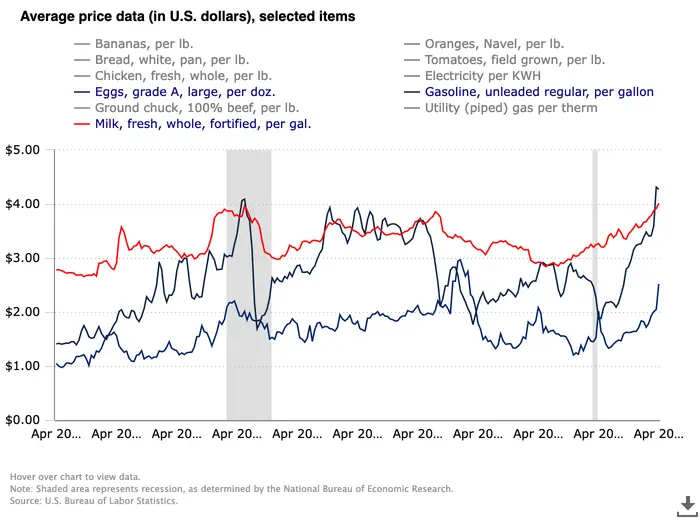
Why? Because of inflation.
Inflation is the increase in the price of goods and services over time.
In other words, things become more expensive and our dollars buy less than they used to.
How does inflation benefit companies?
When goods cost more, companies generate higher revenue and profit. With higher revenue and profit, the stock price of these companies increases.
Inflationary growth, however, is not the same as what is called real growth.
If the stock market doubles, but the cost of living also doubles, you’re no better off than before. Nominal growth4 in this case is 100%; real growth is 0.5
2. Population growth
Population growth means more customers. With more customers, companies are able to sell more of their goods and services and increase their profits.
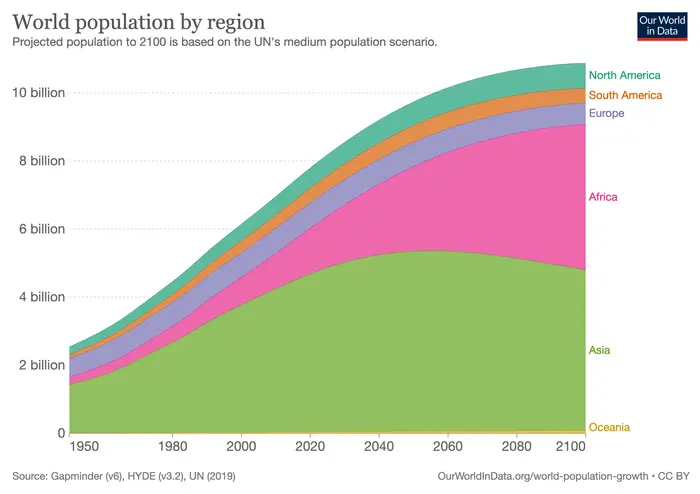
Chart courtesy of Our World in Data.
Population growth also means more workers. With more workers, a company can increase its production of goods as well as create new technology.
More goods produced and sold increase revenue and profits. New technology, meanwhile, creates new industries and can help workers become more productive.6
This again leads to increased revenue and profits.
3. Technology
New technology creates new industries, expands the scope of existing industries, and makes people more productive.
Sidenote
The pace of innovation—partially due to population growth—has grown by leaps and bounds over the past 50 years.
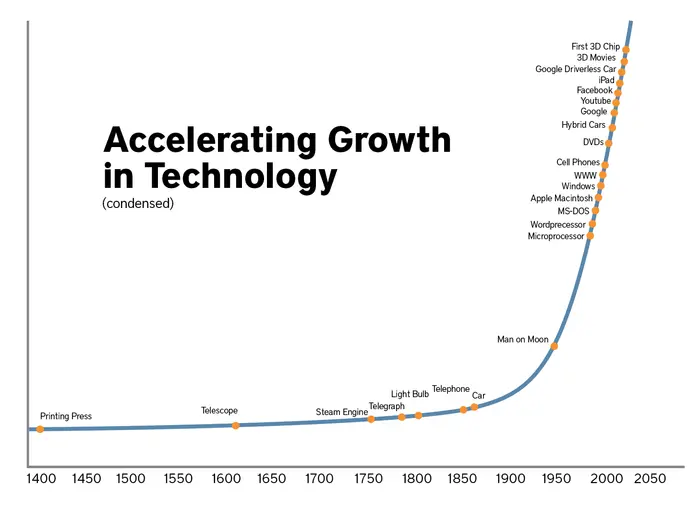
Chart courtesy of Our World in Data.
Improved transportation, for example, allowed people to move away from cities, which is where the jobs were traditionally located. Cities expanded over time as a response to the improved mobility, creating new cities and suburbs.
This urban sprawl gave companies more flexibility as to their physical location as well as access to a larger pool of workers. It also made it easier to start a new company.
The new modes of transportation also required new auxiliary industries (e.g., tire makers, auto mechanic shops, car part makers, road builders, etc.)
Nowadays, the Internet and computers have made location nearly obsolete. A company can be started almost anywhere. Its candidate pool has no geographical boundaries.
More importantly, companies no longer have to start from scratch.
They can use the cloud and avoid the massive expense of having to build out their own data centers. They can use the existing Internet and logistics infrastructure to reach more customers.
Sidenote
A modern-day shoemaker can create a website in less than a day and start shipping their shoes worldwide on the next.
Compare this to the cobbler in the 1800’s who had to rent a physical storefront and was limited to customers in his immediate area.
This dramatic shift applies to nearly every profession—musicians, painters, teachers, etc.
The young, hip, and highly-valued companies of today—Airbnb, Uber, DoorDash, Allbirds, etc.—would not be around were it not for the existing infrastructure they rely on—building all these components themselves would’ve been impossible in terms of time and money.
4. Natural selection
Natural selection and the survival of the fittest apply as much to biology as they do to business.
Sidenote
Charles Darwin used the phrase “natural selection” to describe how organisms best adapted to their environment are more likely to survive and reproduce, passing down their genes to the next generation.
The phrase “survival of the fittest” was coined by Herbert Spencer, an English philosopher, to describe the same concept. Darwin liked the phrase and in later editions of On The Origin of Species began to use it himself.
Darwin wrote in the introduction to these later editions:
I have called this principle, by which each slight variation, if useful, is preserved, by the term Natural Selection, in order to mark its relation to man’s power of selection. But the expression often used by Mr. Herbert Spencer of the Survival of the Fittest is more accurate, and is sometimes equally convenient.
The hope of making money drives people to start businesses. There are only so many dollars to go around, however, so these companies have to duke it out in an attempt to woo customers.
Only the “fittest” companies7 will survive and expand.
But survival is a daily challenge.
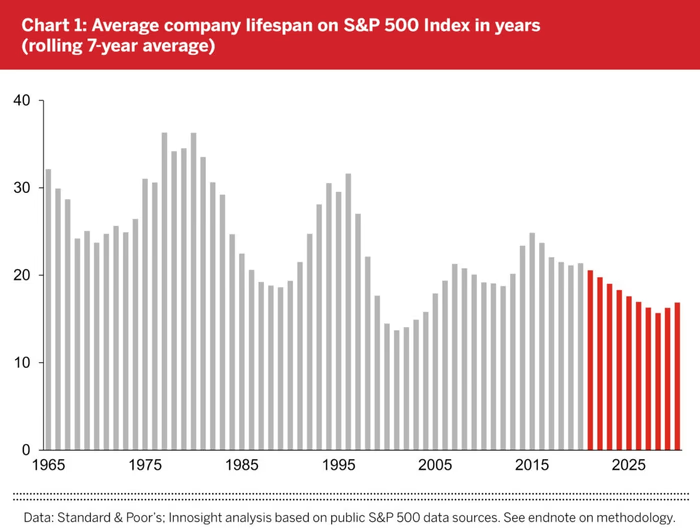
Chart courtesy of Innosight.
The presence of money encourages competitors to jump into the fray—profitable business models are copied8 and smaller, nimbler companies decide to take on larger, slower-moving ones.
With more options available in the market, companies have to tussle for customers. To win, they have to offer better prices or a superior product.
Competition is the law of the land. And it’s competition that ensures that only the “best”9 companies stick around.
So while we don’t know which companies will be the strongest in the future, we know that they’ll be part of the stock market. And their presence will drive up the value of the market.
Sidenote
The hospitality industry long supported many giants such as Hilton, Mariott, and IHG.
Building hotels around the world, however, is expensive and time-intensive. What if a company instead used newer technology (e.g., the Internet, the cloud, smartphone apps) to turn existing homes into something like hotels?
Enter Airbnb.
In 2013, Hilton’s revenue was 7 times higher than Airbnb’s; IHG’s was 4 times higher.
By 2018, Airbnb’s revenue was higher than Hilton’s and over 2 times higher than IHG’s.
Nowadays (2022) Airbnb has 6 million listings in over 220 countries compared to 983,465 rooms in 118 countries for Hilton.
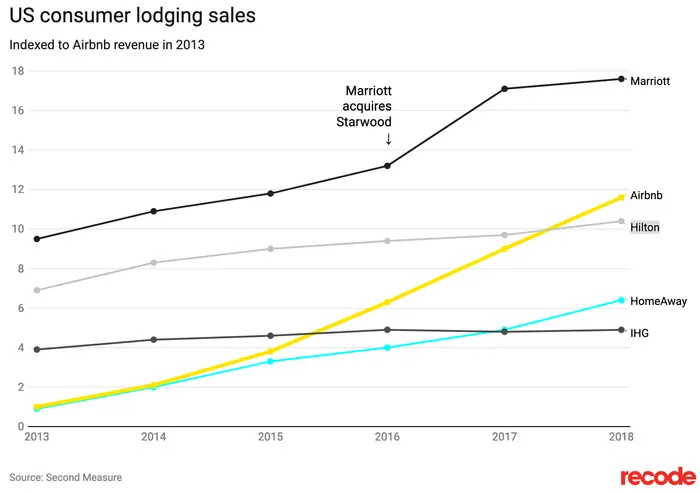
Chart courtesy of Vox.
5. Animal spirits
John Maynard Keynes, an English economist, used the phrase animal spirits to describe how humans are driven by instinct, biases, and emotion rather than by hard logic and mathematical calculations.
There’s a bidirectional relationship between how we feel—as a collective—and the economy: it’s not only that a growing, prosperous economy makes us feel good—our feeling good can also result in an improved economy.
Said another way, low consumer confidence can stunt growth even if the conditions are ripe for economic prosperity and high consumer confidence can promote growth during challenging times.
As humans are irrational, all human creations—the economy and stock market included—will have their fair share of irrationality baked in as well.
Even apart from the instability due to speculation, there is the instability due to the characteristic of human nature that a large proportion of our positive activities depend on spontaneous optimism rather than mathematical expectations, whether moral or hedonistic or economic.
Most, probably, of our decisions to do something positive, the full consequences of which will be drawn out over many days to come, can only be taken as the result of animal spirits—a spontaneous urge to action rather than inaction, and not as the outcome of a weighted average of quantitative benefits multiplied by quantitative probabilities.
Will the stock market increase forever?
We shouldn’t be delusional, however. The previous growth of the U.S. stock market does not mean that it will continue to grow indefinitely.
The past is not a guarantee of the future; infinite growth is untenable.
The past 40 years of the Nikkei 225, the Japanese version of the S&P 500, have not been sunshine and rainbows.
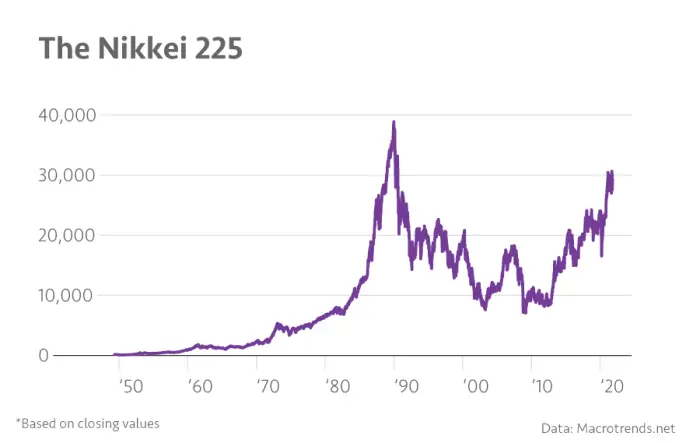
Chart courtesy of Janet Nguyen/Marketplace.
The Nikkei 225 peaked in 1989 and then went into a long decline.
By 2009, twenty years after the peak, the index had fallen 82%—a dollar invested in the Nikkei 225 in 1989 would have been worth a measly 18 cents in 2009.
The Nikkei 225 has since somewhat recovered but it is still nowhere near the 1989 peak.
Why did this happen?
One factor is Japan’s low population growth.
In 2005, the death rate surpassed the birth rate for the first time and since 2007 Japan’s population has been decreasing—the population in 2021 numbered 125,502,000 down from its high of 128,083,960 in 2008.
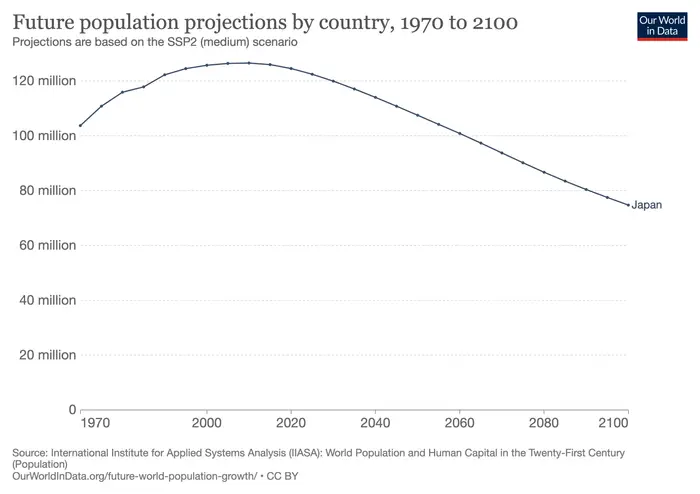
Chart courtesy of Our World in Data.
Not only is Japan’s population decreasing, however, it’s also aging faster than any other nation.
In 2020, 28.8% of the population was over 65 years old, close to double the percentage seen in the United States (16.3%).
A dwindling and aging population means more people needing care and less people available to provide it. It means fewer workers and decreased economic productivity.
Immigration could help.
The most decisive mark of the prosperity of any country is the increase of the number of its inhabitants.
But Japan’s history of isolation and cultural distaste of foreigners has deterred this. Only 2.29% of the population is foreign-born, six times less than the percentage in the United States (13.5%).
A second factor is Japan’s deflation as compared to the U.S.’s inflation.
While the cost of living has nearly quadrupled in the United States over the past 40 years, it’s stayed relatively steady in Japan.
People in Japan have a strong expectation for prices to remain low which makes it difficult for companies to raise prices without costumers revolting.
With little growth in revenue, companies haven’t expanded or raised wages. With no raise in wages, there’s a lack of demand for goods and services. It’s a self-reinforcing loop.
The lack of demand is only worsened by Japan’s aging population—a twenty-year old is much more likely to buy an iPhone and eat out at a restaurant than an eighty-year old.
While these two factors—a dwindling, aging population and deflation—have certainly played a role, the complete explanation for Japan’s economic downturn is a complex topic on which whole books have been written.
Check out the Lost Decades entry in Wikipedia if you’re interested in learning more.
Sidenote
Note also that while the decline of the Nikkei 225 might give the idea that Japan is now in shambles, this might not be the reality.
The western model of inflation and economic growth at all costs is not the only way to run an economy. It might not even be the best one. 🤷♂️
Summary
Here’s what you should take away from this post:
- The U.S. stock market has greatly increased over the past 100+ years.
- This hasn’t been a constant increase—it’s been a bumpy, stomach-turning ride.
- There have been many recessions, depressions, and vertiginous stock drops. And there will be more in the future.
- Not every company in the stock market will thrive over time. The vast majority, in fact, are long gone and forgotten.
- We can reasonably expect that the market as a whole will increase over time even as each individual company dies.
- Think of how the individual cells in our bodies are constantly dying and being replaced while our body as a whole grows and flourishes.
- The stock market isn’t magic; there are reasons for its increase.
- The first four reasons—inflation, population growth, technology, and natural selection—explain the fundamental logic of the stock market.
- The fifth reason—animal spirits—explains why the stock market does not always behave rationally. That is, if humans—creators and sole participants of the stock market—are irrational, how can the stock market not be irrational as well?
- Past success doesn’t guarantee future success and infinite economic growth is impossible.
- The Nikkei 225 peaked in 1989 and then went into a long decline. Thirty-three years later, it has yet to climb back to this peak.
- Will the U.S. stock market experience another century of growth? Who knows.
- Remember, though, that the stock market isn’t life. Life in Japan has gone on despite the poor performance of the Nikkei 225.
In the upcoming posts we’ll continue expanding our knowledge of the stock market and investing by taking a look at how we can participate in the growth of the market while avoiding the fire-breathing dragons.
I hope this was helpful. Send me an email if you have any questions.
And if you’re looking to learn more, you can check out the whole Personal Finance Basics Series.
Video for this post
If you prefer watching to reading, here’s an easy-to-follow video I made with all this info:
Slides for this post
If you’re interested, check out the slides I made for the video.
Stay in touch!
Enjoying so far? Get my posts delivered straight to your inbox each week. 📨
*If this form gives you any trouble, reach out to me at hi@pathtosimple.com and I’ll help you out.
Footnotes
-
The Dow was at 55 in 1915 which turns into 1,500 when adjusting for inflation. See the historical annual data for the Dow. ↩
-
And that’s after adjusting for inflation—it would be $35,927 otherwise. (See Final amount, nominal on the table on the right.) ↩
-
Given its spot as one of the world’s most loved brands, I’d think yes. ↩
-
Nominal growth is growth without adjusting for inflation.
If your income in 1950 is $10 and in 2000 it’s $20, your nominal growth in income is 100% (double).
But this doesn’t mean you can afford twice as much in 2000 as in 1950 because the cost of goods has also increased (inflation).
So while your nominal growth in income is 100%, your real growth is much less. ↩
-
At least, though, you’re not falling behind.
If you weren’t investing in the stock market, you’d be stuck with the same amount of money in a world where the cost of living had doubled, forcing you to stretch your dollars to maintain your previous standard of living. ↩
-
For example, a sewing machine greatly increases the number of shirts that can be made in a day. ↩
-
That is, those who best serve their market and make the most profit. ↩
-
For example, Instagram copying Snapchat’s Stories feature. ↩
-
In other words, the most profitable; not necessarily the most noble, kind-hearted, or environmentally friendly. ↩
